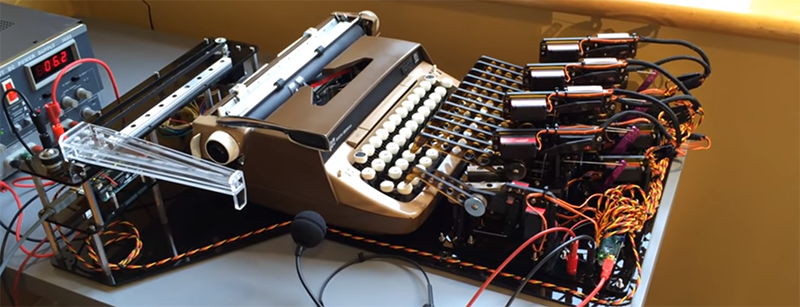Typewriters with voice recognition have existed for over one hundred years; they were called secretaries. Robots are taking all the jobs now, and finally dictation and typing is a job that can be handled by a computer. [Zip Zaps] used an old Smith Corona typewriter to automate the process of turning dictation into print. Like a secretary hunched over an anachronistic IBM Selectric in the first season of Mad Men, this robot will take dictation and accept the overt sexism of a 1960s Manhattan ad agency.
Instead of the machinations of a few biological actuators, this typewriter is controlled with an array of servos driven by Pololu Maestro servo controller. There are twelve servos that move a small actuator down onto the keys, and another twelve servos that move the others above the correct row of the keyboard. The carriage return lever is actuated by a stepper motor, linear rail, and giant plastic lever.
While a robot that can use a typewriter is impressive, the real trick is getting it to take dictation. [Zip Zaps] used the built-in voice recognition found in Windows for this, streaming characters over a serial port to the Arduino-based electronics.
Does it work? Yes, surprisingly it does. Is it useful? Well, typewriters naturally have a cleaner, more analog tone about them, and you can’t replicate the typing experience of an old Smith Corona typewriter with a digital format. This build is just the natural extension of what digital electronics are capable of these days, and we look forward to seeing someone with this amazing device in our local Starbucks.
















Cool, and a bit Steampunk to boot.
At last, what Isaac Asimov wrote about in “The Foundation Trilogy” in the 1950’s.
If you were old enough, you would remember a product like this back in the S100 computer days that you would place over the keyboard of a standard IBM Selectric typewriter, to enable you to connect it as a printer. Solenoids would trigger down and push the keys as directed by the output from a PC. Since printers were rare and expensive, and typewrites were everywhere, these gadgets were middlin’ popular.
“Well how do you expect me to type? With my nose??”
https://www.youtube.com/watch?v=RdprKxOHfys
Damn you beat me too it!
Way better than what I was going to post.
“if this had been an actual carriage return, the the attention motion you just saw would have been followed by….”
Awesome…
Apparently walls of text are what all the cool kids are doing these days. I guess I should get used to swiping 6 times just to get past a single story.
Swear to god… what a bunch of talentless hacks youve become HaD.
Aaight… straight up- the [continue reading] wasn’t there the first time.
Oop… no there it is. The post beforw this one was the wall of text, I just swiped harder than I thought when I went back up.
Dude, chill out.
Now you have created a wall of text, dear God what will I do!
:worry:
Who is this mystery [Zip Zaps]?
I seem to recognize her voice from another video. I’m guessing she is from HaD staff.
Great project … must have cost a fortune.
As soon as I heard her I thought “Jeri Ellsworth, is that you?”
Could be ???
Who do others think may be the mystery [Zip Zaps]?
https://www.youtube.com/watch?v=cLy0mVkoLio
//platform.twitter.com/widgets.js
LOL – too late now – no edit button.
Some people have far too much free time and money on their hands.
It’s better than having too little time or money.
Strictly you are correct. But I was alluding to my opinion that the time could have been put to more productive use.
Competing for the “worst comment on HaD 2016” – award?
Nope – you win.
Sometimes it’s not about free time or money, its about doing something because it’s cool.
nice wire management
i wonder what kinda voice recognition thing did he used?
Yes, the most critical part of the design is….
left out.
RTA?
“While a robot that can use a typewriter is impressive, the real trick is getting it to take dictation. [Zip Zaps] used the built-in voice recognition found in Windows for this, streaming characters over a serial port to the Arduino-based electronics.”
1913 and 1961 come up as times when this was really done with various results. The first was a spectral responder and the later the great Dr. Harry Olson was a phonetic device. I seem to remember he did something like this at the 1939 worlds fair too.
Hint HaD a great story, like. He’s responsible for advancing the state of hifi with interesting double blind experiments with listeners and a physical low pass “filter” and live music.
Good luck with the voice recognition. After 30-40 years, it is as unreliable as in it’s first days.
:o(